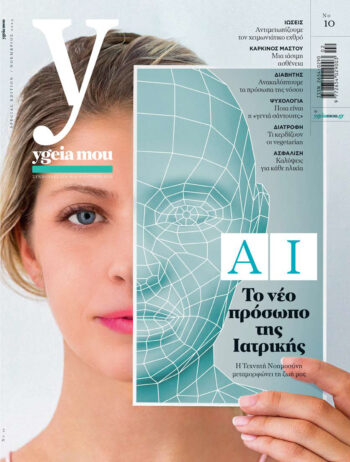[ad_1]
Cataract is one of the leading causes of blindness worldwide, according to the WHO. It is one of the most serious eye diseases in advanced societies and affects 15 million people worldwide, now at increasingly young ages. Recognizing the problem, the WHO has set a goal by 2030 to address the phenomenon by increasing interventions by 30%
Our eye, as a bionic camera, consists of a system of clear and non-clear tissues that aim to clearly capture the image on the eye’s sensor, the retina. These clear parts include the crystalline lens, which is located behind the iris of the eye. The crystalline lens looks like a 10mm diameter bead and helps focus sharply at different distances. THE cataract is the condition in which this lens loses its transparency and becomes cloudy. This blurring results in progressive vision loss.
Cataract is commonly present in the third age. In recent years, however, appears at younger and younger ages. One of the causes blamed for this change is increased exposure to harmful solar radiation due to the thinning of the ozone layer. Sometimes, cataracts can be caused after an injury to the eye, from certain inflammations, or even from taking medications. Taking cortisone by mouth for a long time or more often instilling cortisone eye drops can lead to cataracts at younger ages. Cataracts can also occur after intraocular procedures, such as after an anti-glaucoma operation or a vitrectomy in eyes that have suffered a retinal detachment. People suffering from diabetes mellitus, as well as people with high myopia, develop cataracts earlier. In other, rare cases, it can occur in the newborn, infant or childhood (congenital cataract), if the mother has contracted an infectious disease (eg, rubella) during pregnancy.
The symptoms
The first symptoms of cataracts are a progressive decrease in vision, intense glare in light, frequent change of glasses, blurred vision, difficulty driving at night due to many reflections from car lights, and impaired perception. of colors. Sometimes, patients begin to read better up close because of the nearsightedness caused by a certain type of cataract, nuclear. The improvement is temporary and is usually accompanied by a significant reduction in distance vision. All of the above affect the person’s daily functions, causing difficulties in reading, writing, watching TV, sewing, driving and in advanced cataracts even walking. Quite often, elderly people with cataracts are seriously injured after falls due to poor vision. Fractures caused by misjudging the height on white marble steps are very common.
Diagnosis and treatment
The diagnosis of cataract is made after an examination by the ophthalmologist. Cataract treatment is only surgical. The decision on when to have surgery depends on the degree of reduction in visual acuity, the severity of the cataract, the needs and general condition of the person. In the past it was believed that cataracts should be operated on when they are very advanced (mature). For many years, due to a change in surgical technique, the cataract should not be too advanced or hard, because otherwise the possibility of complications and the postoperative recovery time increase.
Over the past twenty years, cataract surgery has evolved from simply removing the cataractous lens to a refractive surgery in which the eye surgeon has the ability to correct some or all of the eye’s refractive errors. That is, it can correct myopia, hypermetropia, astigmatism and presbyopia, simultaneously with her removal of the cataract. This is achieved by implanting a tiny artificial lens, the intraocular lens, in place of the cataract lens that has been removed. Intralenses are divided into monofocal and multifocal. Both categories can be accompanied by surface modifications that also correct astigmatism.
Monofocal intraocular lenses focus on only one of the three distances we see (far, intermediate, or near). In other words, they offer vision without glasses either far (driving, TV, etc.), or in the middle distance (computer, manual work), or near (reading, cell phone). The person should use glasses to see at the other two distances, unless an intraocular lens is placed for a different distance in each eye (Monovision method). However, if a multifocal intraocular lens is used then, in most cases, the glasses will not be needed at all.
A necessary condition for using a multifocal intraocular lens is the good general condition of the eye and the simultaneous correction of astigmatism, if present, with astigmatic multifocal intraocular lenses. In recent years we have had a special class of multifocal intraocular lenses available, the enhanced depth of focus (EDOF) intraocular lenses, which offer good vision at medium distance without having much refraction in night driving. The selection of the most appropriate intraocular lens is based on the needs of the patient. The multifocal intraocular lens is not indicated in eyes with changes in the macula at the bottom of the eye, in eyes with problems in the cornea, in people of very advanced age and in general in eyes with pathological conditions. It is also not recommended for people with a nervous temperament and for people who are easily disturbed by light reflections when driving at night.
The FLACS method
About forty years ago, cataract surgery began to be performed using the ultrasound phacotripsy method, which is still the conventional method used by the majority of ophthalmologists in Greece. Modern cataract surgery nowadays is called Femtosecond Laser-Assisted Cataract Surgery (FLACS) and is performed using the Femtosecond Laser and ultrasound. The Femtosecond laser, with a precision of a tenth of a millimeter, perfects the first stages of refractive cataract surgery, facilitating the surgeon in the next ones, which are carried out with the use of ultrasound.
Within 30 seconds, the Femtolaser creates the tiny incisions without a scalpel, opens a circular hole in the surface of the lens, and then cuts it into 4 or 6 pieces. This first phase of the operation is controlled exclusively by joystick and trackball through monitors and without eye contact of the surgeon. The tiny incision provides great safety and rapid healing during surgery without causing postoperative astigmatism. The fragmented lens is then aspirated with the help of a special ultrasound machine through the same small puncture. The casing (or bag) of the cataract is cleaned and inside this bag, the intraocular lens is placed, after first being folded with a special tool so that it can fit through the small incision. The operation is performed with special anesthetic drops, without injections into the eye, and the patient can return home immediately afterwards. The whole operation is painless and bloodless. Most of the time no stitches are needed. The duration of the operation is approximately 8 to 12 minutes. The FLACS method is considered the most modern method worldwide to treat cataracts.

The topic was published in issue no. 10 of the ygeiamou magazine which was released with THE TOPIC on Saturday 28/10/2023
